In August 2025, the price of Ethereum (ETH) broke through $3,900, and the ETH/BTC exchange rate reached a six-month high, resulting in a significant reversal in market sentiment. Institutional investors accelerated their positioning, with SharpLink Gaming increasing its ETH holdings to 530,000, exceeding a market value of $2 billion.
Liquidation of short positions and surging open interest in the derivatives market indicate fierce battles between bulls and bears. Analysts predict that the ETH/BTC exchange rate may continue to rise, with a target price for ETH potentially reaching $16,000, reflecting the market's long-term optimism for the Ethereum ecosystem.
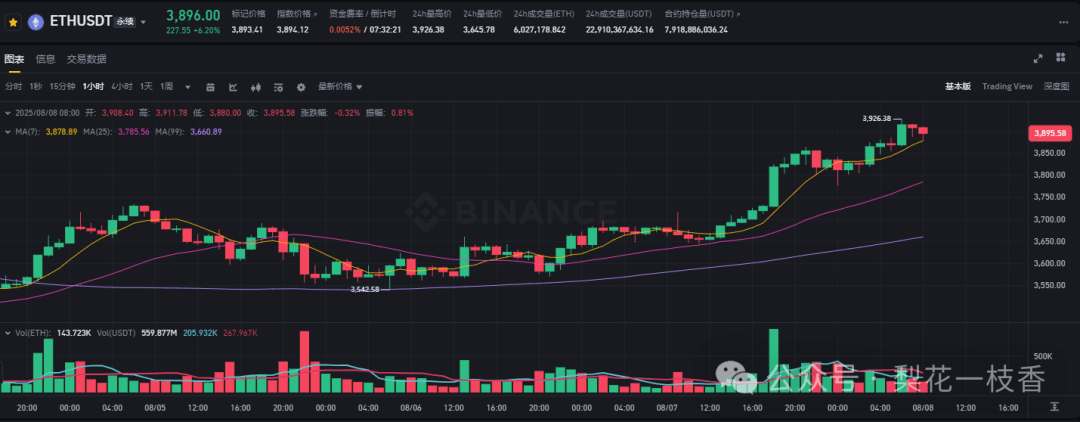
In a hot atmosphere in the cryptocurrency market, Ethereum (ETH) rapidly broke through the $3,900 mark at 6 AM Beijing time on August 8, 2025, while the ETH to Bitcoin (BTC) exchange rate also climbed above 0.033. This figure not only approached a new high since the beginning of the year, but the ETH/BTC rate also reached its highest point since February 2025, marking a significant reversal in market sentiment and a new round of acceleration in institutional investors' positioning.
As a core asset in the blockchain world, this round of ETH's surge is not an isolated event but stems from a recent combination of multiple favorable factors: from large-scale reserve increases and financing actions by publicly traded companies to key derivatives data supporting market confidence, as well as the concentrated outbreak of insider trading risks and analysts' optimistic predictions for the future.
A series of chain reactions highlights the strong resilience of the Ethereum ecosystem while revealing institutional capital's increasingly proactive participation strategy in turbulent markets. As the total open interest in ETH contracts surges to historical highs, and emerging tokens like Ethena rapidly catch up in market capitalization, Ethereum's market seems to be entering a whole new growth cycle; the potential target price of $16,000 is becoming a hot topic among industry insiders—everything suggests that the cryptocurrency market in 2025 is quietly rewriting the rules with ETH as the vanguard.
SharpLink Gaming's strategic expansion: ETH reserves surpass $2 billion.
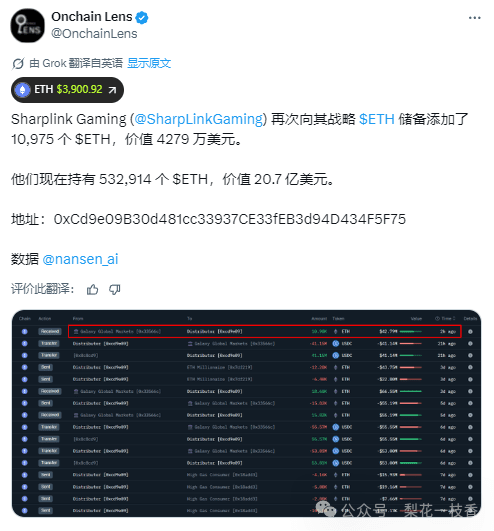
The surge in Ethereum's price is undoubtedly closely related to the aggressive increase in holdings by the publicly traded company SharpLink Gaming. On August 8, according to the Onchain Lens monitoring platform, this Nasdaq-listed company, regarded as the "ETH version of MicroStrategy," has injected an additional 10,975 ETH into its strategic Ethereum reserves, valued at approximately $42.79 million; this move has raised SharpLink's total ETH holdings to 532,914, with a total market value exceeding $2.07 billion. This figure not only consolidates the company's leading position among institutional investors but also echoes its continuous accumulation strategy since the beginning of the year.
It is reported that SharpLink Gaming's business model highly relies on cryptocurrency reserves as core assets, similar to MicroStrategy's Bitcoin-heavy strategy, but it places more emphasis on Ethereum's programmability and ecological diversity. Therefore, the expansion of this reserve scale is seen as an important endorsement of ETH's long-term value.
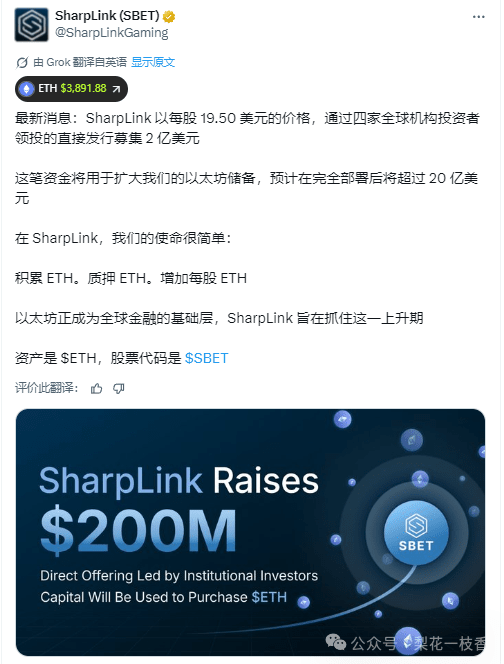
Additionally, in terms of financing, SharpLink announced on August 7 the completion of a $200 million directed issuance transaction through official channels, with an issue price of $19.50 per share, led by four global institutional investors. The financing funds will be specifically used to expand the Ethereum reserve pool, with expectations that after full deployment, its ETH asset scale will stabilize above $2 billion, further reinforcing the liquidity demand for ETH in the market. Analysts point out that SharpLink's action not only reflects the company's trust in Ethereum as "digital gold 2.0" but could also trigger a domino effect, prompting other companies to emulate its model, thereby increasing supply pressure in the secondary market. Meanwhile, as ETH's price rapidly rises, such large-scale institutional buying behavior undoubtedly provides a solid support base for the market, avoiding short squeezes caused by short-term volatility.
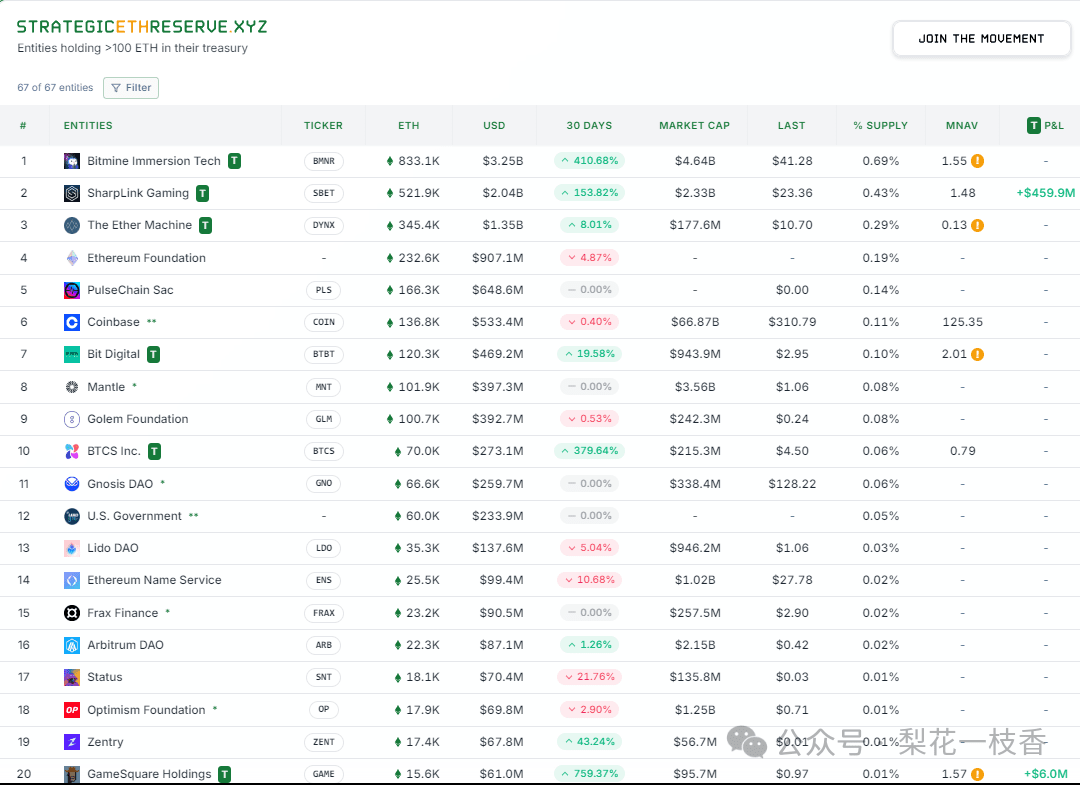
It is worth mentioning that SharpLink's increase in holdings is not an isolated event but unfolds against the macro backdrop of the cryptocurrency market gradually transitioning from speculative to real. As U.S. regulatory policies trend towards relaxation, institutional capital such as pension funds and family offices are accelerating their entry into the crypto space, with Ethereum becoming one of the preferred safe havens for funds due to its mature smart contract and DeFi ecosystem. If we look back at ETH's performance in 2024, the market was once constrained by bear market pressures, with ETH prices testing the $2,500 level multiple times. However, the sustained buying strategies of entities like SharpLink reversed the downward trend. From a deeper perspective, these institutional behaviors reinforce the fundamental narrative of ETH: compared to Bitcoin's "store of value" function, Ethereum has greater expansion potential at the application layer, especially against the backdrop of the booming development of Layer 2 solutions like Optimism and Arbitrum, where the increase in network activity directly drives the surge in demand for ETH as a Gas token. This also creates a sustainable value-adding path for SharpLink's reserve model— in other words, when publicly traded companies are willing to bet heavily on ETH, the confidence boundaries of retail investors are also expanded, and the recent breakthrough of ETH above $3,900 is born from this positive feedback loop.
Derivatives market turmoil: dual signals of short liquidation and position surge.
On the same day that SharpLink increased its holdings, the dramatic fluctuations in the cryptocurrency derivatives market also added a dramatic touch to Ethereum's upward trend.
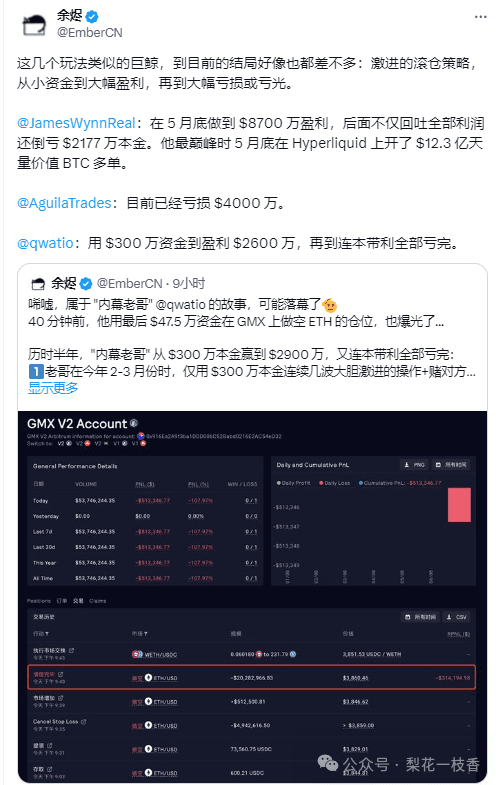
On August 7, according to data disclosed by the Ember Monitoring Platform, an anonymous user identified as an "insider trader" @qwatio, who opened a short position on ETH at the decentralized exchange GMX, ultimately faced liquidation; this trader entered the market with a principal of $3 million six months ago and had realized profits of up to $29 million through ETH price fluctuations. However, during the recent surge, his short position valued at 475,000 USDC was forcibly liquidated, resulting in a total loss of the $3 million principal along with all profits.
This event not only highlights the high-risk nature of the derivatives market but also indirectly confirms the rapid warming of market sentiment: the ETH short strategy faced a complete collapse during this surge, reflecting the absolute dominance of bullish forces; industry analysts believe that @qwatio's case exposes the potential risks of "insider trading," where such behavior often stems from an overinterpretation of short-term data or internal news, while underestimating macroeconomic support (such as the Federal Reserve's potential interest rate cuts) and on-chain fundamentals (such as ETH staking rates reaching new highs), leading to a rapid evaporation of positions when the market turns.
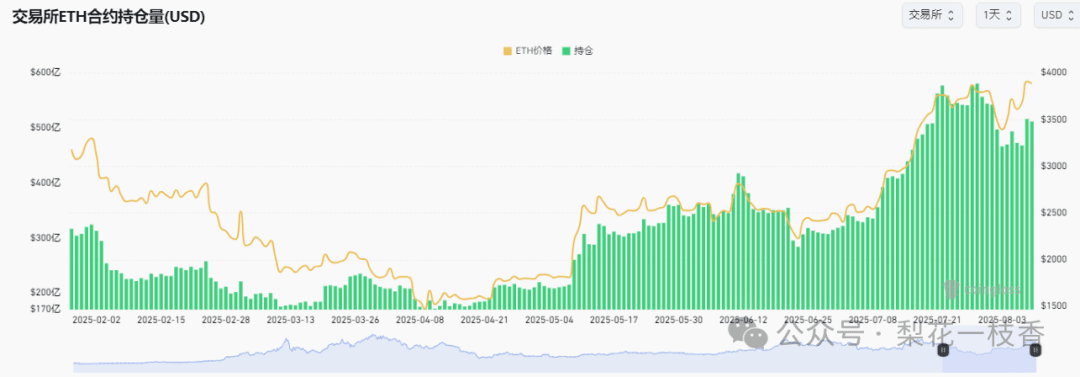
More notably, the overall activity in the ETH derivatives market is simultaneously climbing to historical peaks. According to Coinglass data, the total open interest in ETH contracts across the network increased significantly by 10% within the past 24 hours, with the current total open interest reaching $51.3 billion; among these, Binance leads with an open interest of $10.1 billion, followed by Bybit ($4.486 billion) and OKX ($3.288 billion). These figures reflect the strong demand from global traders for ETH futures and options, especially as leveraged trading based on ETH is becoming a popular strategy among hedge funds.
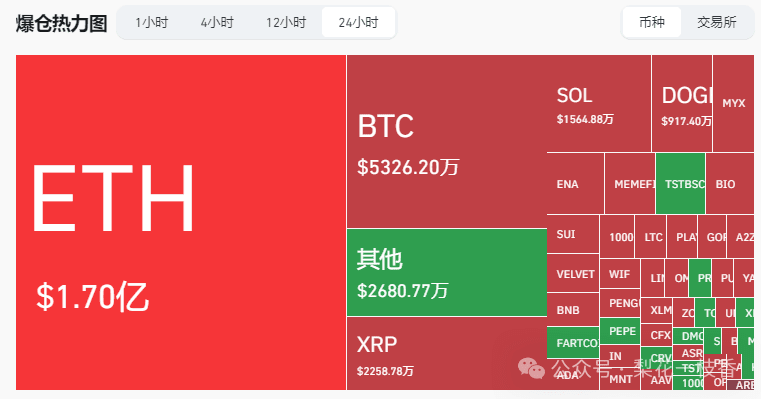
Upon closer examination, the surge in open interest and liquidation amounts is not accidental; it often indicates an intensification of market divergence: on one hand, short sellers continued to increase their positions after ETH broke the $3,900 mark, hoping for a price pullback; on the other hand, bulls took advantage of the situation to position for a breakthrough of the $4,000 mark in the short term, which further amplified the volatility of ETH and set the stage for potential future corrections.
From a positive perspective, the current surge in open interest also reflects the market's increasing long-term confidence in Ethereum, especially as emerging stablecoin protocols like Ethena rise to prominence.
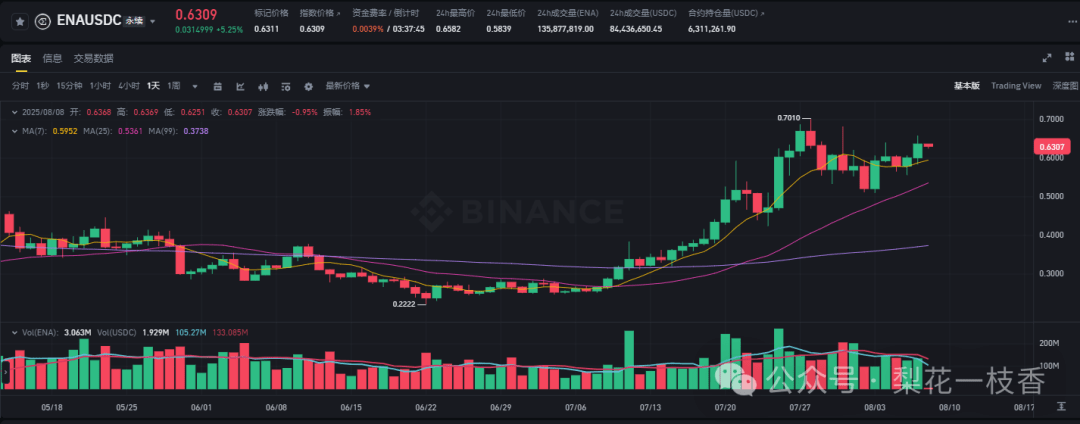
Data shows that Ethena's market capitalization has surpassed the established DeFi protocol Aave, breaking through $4.193 billion, with a 24-hour increase of 11.73%. Its market capitalization has risen to the thirtieth position among cryptocurrencies.
The rise of Ethena is partly attributed to its unique "synthetic dollar" model relying on ETH as collateral. This mechanism directly stimulates the circulation demand for ETH in the derivatives market and indirectly boosts the open interest data. Overall, in the parallel of liquidation tragedies and soaring open interest, the ETH derivatives market is becoming an amplifier of market catalysts, reinforcing its status as the market focus.
Analysts' outlook: a grand prediction from the ETH/BTC recovery to $16,000.
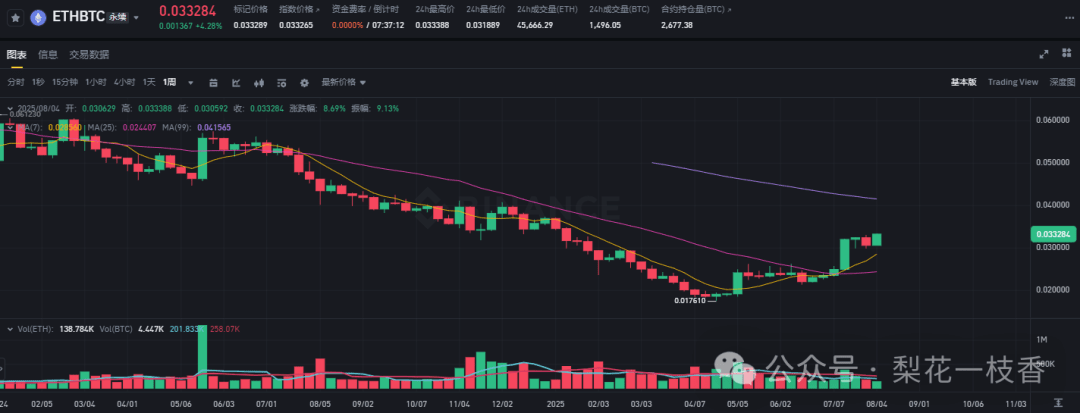
ETH's breakout is not limited to price and derivatives but also demonstrates its structural advantages in cross-asset comparisons. On August 7, the ETH to Bitcoin exchange rate (ETH/BTC) broke through the significant threshold of 0.033, with a cumulative increase of over 83% since mid-April. This recovery trend has sparked strong resonance among top analysts.

Placeholder partner Chris Burniske emphasized in a social media post that "the upward trend of the ETH/BTC exchange rate seems far from over. Considering the Ethereum network upgrades (like the Pectra upgrade) and the enhancement of actual yield capability, this round of market activity may continue until the end of the year, targeting the 0.045 region."
Burniske's view is based on historical data analysis: during the peak of the 2021 bull market, ETH/BTC reached 0.085, while the current 0.033 is only halfway up; the core logic is that Bitcoin's status as "digital gold" dominated the market in 2024, while in 2025, the narrative of Ethereum as a "smart contract platform" is set to take precedence, especially driven by explosive growth in decentralized applications (like Uniswap V4).
Meanwhile, Thomas Lee, Chairman of the Board of BitMine (BMNR), made a more aggressive prediction in an interview with Cointelegraph.
Lee pointed out that based on the high ratio of the ETH/BTC exchange rate in 2021, the single price of ETH is expected to hit the $16,000 range, representing nearly a 400% upside from the current $3,900 level. He explained that Ethereum's valuation model is shifting from "purely on-chain fuel" to a "multi-chain revenue engine," with staking yields (annualized at about 4%-5%), network fee capture (monthly average in the hundreds of millions), and the upcoming upgrade of the burn mechanism (such as the dynamic adjustments of EIP-1559) collectively building the value foundation.
Thomas Lee's calculation framework references historical data from the peak of the 2021 bull market: at that time, when the ETH/BTC exchange rate reached a high of 0.085, the price of ETH broke through $4,800. Currently, while the ETH/BTC is only at 0.033, Bitcoin itself has risen from $20,000 to over $80,000, indicating that ETH's inherent upward potential is underestimated. If ETH/BTC can rebound to 2021 levels, coupled with BTC's market support, a target of $16,000 is reasonable. Interestingly, Lee's prediction is gradually becoming the industry consensus, with Goldman Sachs and Morgan Stanley recently raising their year-end forecasts for ETH, setting the target range at $10,000 to $12,000.
Furthermore, the breakout of ETH/BTC is not only a victory for technical indicators but also stems from favorable macroeconomic changes. On one hand, the Federal Reserve's monetary policy is leaning towards easing in the second half of 2025, and the rising expectations for interest rate cuts have weakened the dollar index's suppression on risk assets; on the other hand, the clarity of Ethereum's regulation (such as the SEC's potential approval of an ETH spot ETF) has also released positive signals. More importantly, on-chain data supports the sustainability of this round of market: Glassnode reports that the number of active ETH addresses and net inflow to exchanges are both in an upward trend, rather than speculative turnover.
Therefore, when ETH/BTC reached a recent high on August 8, it represented not just a burst of market sentiment but a threefold reconstruction of the Ethereum ecosystem in terms of institutional capital, technological upgrades, and social consensus, laying the foundation for a potential super cycle.
The practical significance and potential path of ETH breaking through $3,900.
Specifically regarding the immediate event of Ethereum breaking through $3,900, this milestone reflects the collaborative effect of multiple forces.
As of the time of this writing, ETH is priced at $3,905, with a 24-hour increase of over 7%, and a cumulative pullback of less than 3% since the end of July, showcasing a rare single-sided strength.
In analyzing this breakout, it is essential to consider the aforementioned multidimensional factors: first, the reserve increases by institutions such as SharpLink provide a "demand anchor" for the market, creating buying pressure by reducing circulating supply (its holding of 532,914 ETH accounts for nearly 0.3% of Ethereum's total circulating supply); second, the combination of liquidation events in the derivatives market and the surge in open interest creates a "short squeeze" environment, especially given that the open interest in ETH contracts has exceeded $50 billion, where minor price fluctuations could trigger chain reactions to accelerate short position liquidations; third, the continued rebound of the ETH/BTC rate releases signals for cross-asset rotation, attracting Bitcoin capital back to the Ethereum ecosystem.
In conclusion, the breakthrough of the $3,900 mark not only signifies that ETH has completely reclaimed the ground lost during the 2024 bear market but also marks the market's entry into a new "valuation reassessment" phase. The key resistance levels on technical charts (such as around $3,950 on the 4-hour chart) have become a springboard for bulls to target the next goal of $4,000.
Looking ahead, the potential path for ETH is full of opportunities but also hidden risks.
On the positive side, Thomas Lee's $16,000 prediction is not a fantasy; if ETH/BTC moves towards the 0.05 region (a historical resistance level), combined with Bitcoin's market cap stabilizing above $80,000, ETH could easily leap to around $6,000. Furthermore, if network activity and staking yields continue to rise, the valuation model could support even higher targets.
However, risk factors cannot be ignored: extreme positions in the derivatives market could trigger short-term pullbacks (such as repeated testing of the support level near $3,900), while macroeconomic black swans (such as geopolitical conflicts or inflation data exceeding expectations) may also disrupt the upward momentum. Moreover, the lessons from liquidations remind market participants to exercise caution with leverage.
Nevertheless, the foundation of Ethereum—including its decentralized finance (DeFi) locked value exceeding $100 billion, the recovery of the NFT market (such as a rebound in OpenSea trading volume), and the booming development of real-world asset (RWA) protocols—provides a buffer for the price. In the long run, breaking the $3,900 mark may just be the prologue for ETH to redefine the cryptocurrency market landscape once again.



